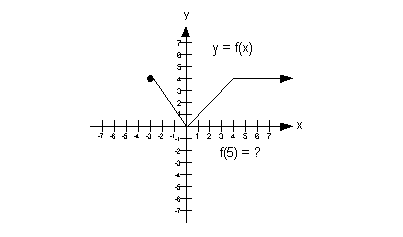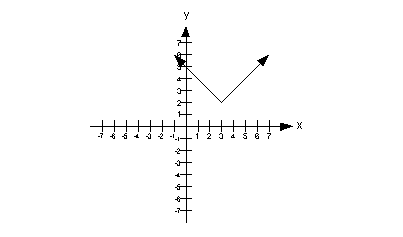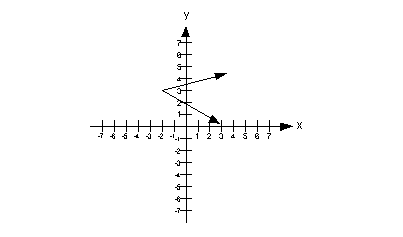College Algebra
Answer/Discussion to Practice Problems
Tutorial 33: Practice Test on Tutorials 25 - 32
Problems 1a - 1c: Find the slope of the straight line that
passes through the given points or state that the slope is undefined.
Then indicate if the line through the points rises (left to right), falls
(left to right), is horizontal, or is vertical. |
1a. (7, 4) and (1, 1)
 Answer: Answer:

Since the slope is positive, the line would rise (left to right). |
|
1b. (-3, 4) and (2, -1)
 Answer: Answer:

Since the slope is negative, the line would fall (left to right). |
|
1c. (-5, 3) and (-5, 2)
 Answer: Answer:

The slope is undefined.
Since the slope is undefined, the line would be vertical. |
|
Problems 2a - 2d: Write an equation for the line in point/slope
form and slope/intercept form that has the given condition. |
2a. Slope = 3/2 and passes through the origin.
 Answer: Answer:
Point/Slope Form:

Slope/Intercept Form:
 |
|
2b. x-intercept = 4 and y-intercept
= -3
 Answer: Answer:
Slope:

Point/Slope Form:

Slope/Intercept Form:

|
|
2c. Passes through (3, 2) and is parallel to  .
 Answer: Answer:
Slope:

Slope of line parallel to this line would be m = 2.
Point/Slope Form:

Slope/Intercept Form:
 |
|
2d. Passes through (-1, -1) and is perpendicular to  .
 Answer:
Slope: Answer:
Slope:

Slope of line perpendicular to this line would be m = -2/5.
Point/Slope Form:

Slope/Intercept Form:
 |
|
Problems 3a - 3d: Give the slope and y-intercept
of the given line and then graph it. |
3a. 
 Answer: Answer:
Slope/Intercept Form:

Slope and y-intercept:
Lining up the equation with the slope/intercept form we get
slope = m = 2/3
y-intercept = b = -2

|
|
3b. 
 Answer: Answer:
Slope/Intercept Form:

Slope and y-intercept:
Lining up the equation with the slope/intercept form we get
slope = m = -2
y-intercept = b = 0

|
|
3c. 
 Answer: Answer:
Horizontal line:

Slope and y-intercept:
Slope = m = 0
y-intercept = 3 |
|
3d. 
 Answer: Answer:

Vertical line:

Slope and y-intercept:
Slope = m = undefined
y-intercept = none |
|
Problems 4a - 4b: Find the slope of the line that is a) parallel
and b) perpendicular to the given line. |
4a. 
 Answer: Answer:
Slope of the parallel line:
Since parallel lines have the same slope and
this is a vertical line, then the slope is undefined.
Slope of the perpendicular line:
Since vertical and horizontal lines are perpendicular
to each other and this is a vertical line, then the slope of the perpendicular
line in this case would be the slope of a horizontal line which would be
0. |
|
4b. 
 Answer: Answer:
Slope of the parallel line:
Since parallel lines have the same slope and
this is a horizontal line, then the slope is 0.
Slope of the perpendicular line:
Since vertical and horizontal lines are perpendicular
to each other and this is a horizontal line, then the slope of the perpendicular
line in this case would be the slope of a vertical line which would be
undefined. |
|
Problem 5a: Write the standard form of the equation of the circle
with the given center and radius. |
5a. center (-2, 0) and r = 3
 Answer: Answer:

|
|
Problem 6a: Find the center and radius of the given circle
and graph it. |
6a. 
 Answer: Answer:

Lining up the equation with the standard form we get
center = (h, k)
= (0, -5)
radius = r = 2

|
|
Problems 7a - 7b: Determine if the given relation is function
or not. Give its domain and range. |
7a. {(-1, 2), (1, 3), (-1, 4), (2, 5)}
 Answer: Answer:
Is this a function or not?
Since the input value of -1 goes with two output
values, 2 and 4, this relation would not be an example of a function.
Domain
The set of all input values would be {-1, 1,
2}.
Range
The set of all output values would be {2, 3,
4, 5}. |
|
7b. {(1, 1), (2, 2), (3, 3), (4, 4)}
 Answer: Answer:
Is this a function or not?
Since every first element (or input) corresponds
with EXACTLY ONE second element (or output), this relation would be an
example of a function.
Domain
The set of all input values would be {1, 2, 3,
4}.
Range
The set of all output values would be {1, 2,
3, 4}. |
|
Problems 8a - 8b: Decide whether y is a function of x. |
8a. 
 Answer: Answer:

At this point we ask ourselves, would we get one value for y if you plug in any value for x?
Since the answer to that question is yes, that means by definition, y is a function of x. |
|
8b. 
 Answer: Answer:

At this point we ask ourselves, would we get one value for y if you plug in any value for x?
Since the answer to that question is no, that means by definition, y is NOT a function of x. |
|
Problem 9a: Find and simplify a) f(a),
b) f(a + h)
and c)  using the given function.
using the given function. |
9a. 
 Answer: Answer:
f(a):

f(a + h):

Putting it all together we get:
 |
|
Problem 10a: Find the functional values f(-5), f(1),
and f(3) for the compound function. |
10a. 
 Answer: Answer:
To find f(-5), we need to go to the piece
of the function that x = -5 would be under,
which would be the first one where x < 1:

To find f(1), we need to go to the piece
of the function that x = 1 would be under,
which would be the first one where x < 1:

To find f(3), we need to go to the piece
of the function that x = 3 would be under,
which would be the second one where x > 1.

|
|
Problems 11a - 11c: Give the domain of the function. |
11a. 
 Answer: Answer:

The domain would be all real numbers except -5 and 5. |
|
11b. 
 Answer: Answer:
The domain is all real numbers. |
|
11c. 
 Answer: Answer:

Domain is x > 2/5. |
|
Problems 12a - 12e: Graph the given function using the given
values of x. Also use the graph
to determine the domain and range of the function. |
12a.  ; x = -3, -2, -1, 0, 1, 2, 3
 Answer: Answer:
|
x
|

|
(x, y)
|
|
-3
|

|
(-3, 8)
|
|
-2
|

|
(-2, 3)
|
|
-1
|

|
(-1, 0)
|
|
0
|

|
(0, -1)
|
|
1
|

|
(1, 0)
|
|
2
|

|
(2, 3)
|
|
3
|

|
(3, 8)
|

Domain
Since the domain is the set all input values, it corresponds to the x-values
in this problem.
This means that the domain is  . .
Range
Since the range is the set all output values, it corresponds to the
y-values in this problem.
This means that the range is  . . |
|
12b.  ; x = -1, 0, 3, 8
|
12c.  ; x = 0, 1, 2, 3, 4, 5, 6
 Answer: Answer:
|
x
|

|
(x, y)
|
|
0
|

|
(0, 3)
|
|
1
|

|
(1, 2)
|
|
2
|

|
(2, 1)
|
|
3
|

|
(3, 0)
|
|
4
|

|
(4, 1)
|
|
5
|

|
(5, 2)
|
|
6
|

|
(6, 3)
|

Domain
Since the domain is the set all input values, it corresponds to the x-values
in this problem.
This means that the domain is  . .
Range
Since the range is the set all output values, it corresponds to the
y-values in this problem.
This means that the range is  . . |
|
12d.  ; x = -3, -2, -1, 0, 1, 2, 3
 Answer: Answer:
|
x
|

|
(x, y)
|
|
-3
|

|
(-3, 5)
|
|
-2
|

|
(-2, 5)
|
|
-1
|

|
(-1, 5)
|
|
0
|

|
(0, -5)
|
|
1
|

|
(1, 5)
|
|
2
|

|
(2, 5)
|
|
3
|

|
(3, 5)
|

Domain
Since the domain is the set all input values, it corresponds to the x-values
in this problem.
This means that the domain is  . .
Range
Since the range is the set all output values, it corresponds to the
y-values in this problem.
This means that the range is {y | y = 5}. |
|
12e.  ; x = -2, -1, 0, 1, 2
|
Problem 13a: Use the graph to determine a) the x-intercepts,
if any b) the y-intercept, if any, c) the functional value indicated, to
determine intervals on which the function is d) increasing, if any, e)
decreasing, if any, and f) constant, if any. |
13a.

 Answer: Answer:
a) x-intercept
Since the x-intercept
is where the graph crosses the x-axis, the
ordered pair for this x-intercept would be
(0, 0).
b) y-intercept
Since the y-intercept
is where the graph crosses the y-axis, the
ordered pair for this y-intercept would be
(0, 0).
c) Functional Value
Since the functional value correlates with the
second or y value of an ordered pair,
then the functional value at x = 5 is 4.
d) Increasing
Since a function is increasing in an interval
when it is going up left to right in that interval, this function is increasing
on the interval  . .
e) Decreasing
Since a function is decreasing in an interval
when it is going down left to right in that interval, this function is
increasing on the interval  . .
f) Constant
Since a function is constant in an interval when
it is horizontal in that interval, this function is constant on the interval  . . |
|
Problems 14a - 14b: Use the vertical line test to identify
graphs in which y is a function of x. |
14a.

 Answer: Answer:
This graph would pass the vertical line test,
because there would not be any place on it that we could draw a vertical
line and it would intersect it in more than one place.
Therefore, this is a graph of a function. |
|
14b.

 Answer: Answer:
This graph would not pass the vertical line test
because there is at least one place on it that we could draw a vertical
line and intersect it in more than one place.
Therefore, this is not a graph of a function. |
|
Problems 15a - 15b: Determine if the given function is even,
odd or neither. |
15a. 
 Answer: Answer:

Since  ,
then it is an even function. ,
then it is an even function. |
|
15b. 
 Answer: Answer:


Since  ,
then it is an odd function. ,
then it is an odd function. |
|
Problem 16a: If f(x)
= int(x), find the given functional value. |
16a. f(-14.321)
 Answer: Answer:
-15 is the greatest integer that is less than
or equal to -14.321. |
|

Last revised on July 3, 2010 by Kim Seward.
All contents copyright (C) 2002 - 2010, WTAMU and Kim Seward.
All rights reserved.
|
|


